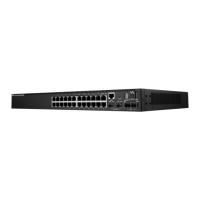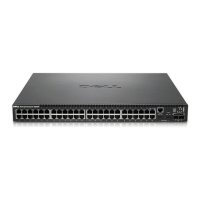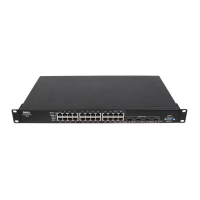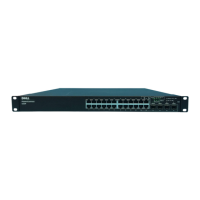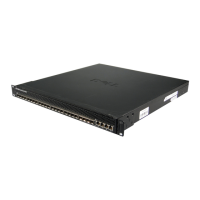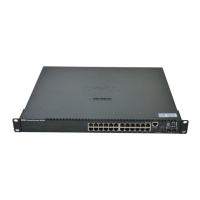
 Loading...
Loading...
Do you have a question about the Dell POWERCONNECT 5548P and is the answer not in the manual?
| Model | PowerConnect 5548P |
|---|---|
| Power Over Ethernet (PoE) | Yes |
| Switching Capacity | 176 Gbps |
| Power | AC 120/230 V (50/60 Hz) |
| Humidity | 10% to 90% non-condensing |
| Type | Switch |
| Device Type | Switch |
| Enclosure Type | Rack-mountable |
| Ports | 48 x 10/100/1000 |
| MAC Address Table Size | 16K |
| Routing Protocol | Static |
| Remote Management Protocol | SNMP |
| Features | Flow control, VLAN support, IGMP snooping, port mirroring, DHCP support, Quality of Service (QoS) |
| Compliant Standards | IEEE 802.3, IEEE 802.3u, IEEE 802.3ab, IEEE 802.3z, IEEE 802.3x, IEEE 802.3af, IEEE 802.3at |
| Jumbo Frame Support | 9216 bytes |
| Power Supply | Internal power supply |
| Operating Temperature | 0 to 45 °C |
| Storage Temperature | -40 to 70°C |
| Management | Web based, CLI, SNMP |
Describes how the device functions as an IPv6-compliant host, enabling operation in pure IPv6 or combined IPv4/IPv6 networks.
Details the system's support for up to eight units with two fixed HDMI stacking ports for enhanced connectivity.
Explains Power over Ethernet (PoE) capability, providing power to devices over existing LAN cabling.
Describes Green Ethernet (Energy Efficient Ethernet) for reducing power consumption and environmental impact.
Explains how to prevent traffic delays and frame loss caused by traffic competing for egress port resources.
Details flow control for enabling communication between devices of different speeds to prevent buffer overflows.
Describes back pressure on half-duplex links to prevent buffer overflows by occupying the link.
Explains VCT for detecting and reporting copper link cabling faults like open cables and shorts.
Describes auto-negotiation for automatic detection of speed, duplex mode, and flow control on ports.
Details MDI/MDIX support for auto-detection of straight-through and crossed cables on ports.
Covers MAC address capacity support and VLAN-aware MAC-based switching capabilities.
Explains Layer 2 features like IGMP Snooping, Port Mirroring, and Broadcast Storm Control.
Details VLAN support, including Port-Based VLANs, 802.1Q tagging, GVRP, and Voice VLAN.
Covers Spanning Tree Protocol features including Fast Link, Rapid STP, Multiple STP, and BPDU Guard.
Describes Link Aggregation for optimizing port usage and increasing bandwidth and redundancy.
Explains QoS features like 802.1p support, Advanced QoS, and TCP Congestion Avoidance.
Details security features including SSL, Port-Based Authentication, Locked Ports, RADIUS, SSH, TACACS+, and Password Management.
Covers DHCP Server functionality, Protected Ports, iSCSI Optimization, Proprietary Protocol Filtering, and DHCP Relay.
Explains Protected Ports feature for Layer 2 isolation between interfaces sharing the same Broadcast domain.
Describes iSCSI optimization features for improving storage networking performance and QoS.
Details proprietary protocol filtering to control specific protocol packets through an interface.
Details the different PowerConnect 5500 series device types and their port configurations.
Describes the structure of the devices, including front panel, buttons, LEDs, back panel, and ventilation.
Explains the meaning of system and port LEDs that indicate status of links, power supplies, fans, and diagnostics.
Details the internal and external power supply units for the PowerConnect 5500/P switches.
Provides an overview of the Stacking feature, allowing multiple switch management through a single switch.
Describes the different modes for units in a stack: Stack Master, Slave Unit, and Master Backup.
Explains how to connect units in a stack using HDMI 10G ports for stacking.
Describes the ring and chain topologies for PowerConnect 5500 series systems operation.
Details how to configure the stack, including adding units and assigning unique unit IDs.
Outlines the steps for configuring switches, including connecting to a terminal and assigning unit IDs.
Provides instructions on connecting the switch to a terminal via the console port for configuration.
Describes the power-on self-test (POST) process and initial LED indications after booting the switch.
Explains how to configure the stack, noting each switch is considered a stack even if only one.
Guides users through initial switch configuration using the Setup Wizard for quick system startup.
Provides general information for using the Command Line Interface (CLI) and its command modes.
Explains how to manage the device using CLI commands via direct terminal connection or Telnet.
Describes methods for retrieving an IP address from a DHCP server or a BOOTP server.
Details system security handled by AAA, including user access rights, privileges, and data encryption via SSH.
Explains how to define Message-of-the-Day, Login, and Exec banners for console and telnet lines.
Describes tasks performable via the Startup menu, such as software download and password recovery.
Provides instructions for downloading device software (system and boot images) via TFTP or USB port.
Provides steps to start the Dell OpenManage Switch Administrator application via a web browser.
Explains the different views on the home page: Tree view, Device View, Components List, and Information Buttons.
Describes the graphical representation of units and port indicators on the home page.
Details the information buttons and device management icons found on the OpenManage Switch Administrator interface.
Defines fields that are user-defined and notes allowed characters, unless otherwise specified on the web page.
Describes common functions performable on many GUI pages, such as Apply, Back, Cancel, and Next.
Enhances network security by limiting port access to users with specific MAC addresses, dynamically learned or static.
Describes Access Control Lists (ACLs) for defining classification actions and rules for specific ingress or egress ports.
Explains how binding an ACL to an interface applies its rules and how to change the default action for unmatched packets.
Details protocol filters used to disallow specific proprietary protocol packets through an interface, enabled for specific ports.
Describes how time ranges can be defined and associated with QoS ACLs for application during specific times.
Explains how to add a recurring time range element to an absolute time range.
Describes Dot1x authentication for port-based network access control using RADIUS and EAP.
Describes how to view and set general switch parameters like Asset Information, System Health, and Power over Ethernet.
Explains how the system clock synchronizes using SNTP servers or manual time settings.
Details the Logs feature, including System Log Overview, Global Parameters, RAM Log, Log File, Login History, and Remote Log Server.
Describes how to configure IP addresses, including IPv4 and IPv6 interfaces, default gateways, and DNS.
Provides information on performing cable tests on copper and fiber optic cables using Integrated Cable Test.
Describes pages used to manage device security, including Access Profiles, Authentication Profiles, and RADIUS.
Explains DHCP server functionality, properties, network pools, excluded addresses, static hosts, and address binding.
Describes managing device firmware and configuration files, including file management overview and auto-update features.
Details how to manage the stack, including stack management overview, unit IDs, versions, reset, and unit identification.
Describes sFlow monitoring of traffic, including overview, workflow, receiver, interface, and statistics settings.
Includes descriptions of port features such as Auto-Negotiation, MDI/MDIX, Flow Control, Back Pressure, and Port Default Settings.
Explains Jumbo frames, which are frames up to 10 Kb in size, and how to enable them for larger packet sizes.
Describes Green Ethernet features designed to reduce power consumption and make the device environmentally friendly.
Details Protected Ports for Layer 2 isolation between interfaces sharing the same Broadcast domain (VLAN).
Explains port profiles for saving and sharing port configurations via CLI commands or built-in macros.
Provides instructions on configuring ports, including description, port type, admin status, and speed/duplex modes.
Details LAG configuration for defining Link Aggregated Groups, including LAG mode, speed, and auto-negotiation.
Explains storm control for limiting broadcast, multicast, or unknown unicast frames to prevent network storms.
Describes the Mirroring feature for forwarding copies of traffic from source ports to a monitoring port for analysis.
Explains how MAC addresses are stored in Static Address or Dynamic Address tables for packet forwarding.
Details how static MAC addresses are manually assigned to specific interfaces and VLANs.
Describes the Dynamic Address Table containing MAC addresses acquired by monitoring source addresses of traffic.
Explains GARP as a general-purpose protocol for registering network connectivity or membership information.
Details how to configure GARP timers on an interface, including Join, Leave, and Leave All timers.
Describes STP's role in providing tree topography, eliminating loops, and supporting Classic, Rapid, and Multiple STP versions.
Explains how to enable STP and select the STP mode (Classic, Rapid, Multiple) on the device.
Details how to assign STP properties to individual ports, including STP, Fast Link, BPDU Guard, and Root Guard.
Describes how to assign STP parameters to LAGs, including STP state, Fast Link, BPDU Guard, and Root Guard.
Explains Rapid Spanning Tree Protocol (RSTP) for faster convergence of the spanning tree without creating forwarding loops.
Describes Multiple Spanning Tree Protocol (MSTP) for detecting and mitigating loops separately in each instance.
Defines VLANs as switched networks logically segmented by functions or applications, rather than physical connections.
Explains how to view VLANs and assign ports to VLANs, detailing port membership codes (Tagged, Untagged, Forbidden).
Describes how to configure port VLAN modes (General, Access, Trunk, Customer, Private VLAN) and acceptable frame types.
Details how to configure LAGs on a VLAN, including LAG mode, type, status, speed, and advertisement settings.
Explains protocol groups based on protocol-based VLANs for classifying traffic by data-link-layer protocol identification.
Describes assigning interfaces to a protocol group, associating them with a VLAN ID or VLAN name.
Details GARP VLAN Registration Protocol (GVRP) for automatic distribution of VLAN membership information.
Explains Private VLANs (PVLANs) for Layer 2 isolation between ports sharing the same Broadcast domain.
Describes the Voice VLAN feature for enhancing VoIP service by configuring ports for IP-voice traffic.
Optimizes port usage by linking ports into a single LAG (aggregated group) for bandwidth, flexibility, and redundancy.
Details how to define LACP LAGs by configuring LACP global and port parameters like system priority and timeout.
Explains how to assign ports to LAGs, where ports acquire LAG properties when added.
Describes multicast forwarding enabling single packet forwarding to multiple destinations using Layer 2 service.
Details how to enable Multicast filtering and IGMP Snooping globally.
Explains how to add and configure a Multicast group, displaying ports and LAGs attached to a Multicast service.
Describes attaching ports or LAGs to a device attached to a neighboring Multicast router/switch after IGMP Snooping.
Explains IGMP Snooping for enabling per VLAN selective IPv4 Multicast forwarding.
Details how to set the action for unregistered Multicast groups on a port, allowing forwarding or filtering.
Describes the Multicast TV VLAN feature for supplying Multicast transmissions to Layer 2-isolated subscribers.
Explains how to set the Multicast Group IP address for a TV VLAN.
Describes LLDP for network managers to troubleshoot and enhance network management via discovering topology.
Details how to enable and configure LLDP on the device, including update interval and hold multiplier.
Explains LLDP configuration per port, including activating notification and selecting optional TLVs.
Describes LLDP-MED network policies, identified by policy number, instructing devices on traffic handling.
Details how to assign MED network policies to ports, specifying LLDP MED status and network policy.
Provides information received in LLDP advertisements from neighboring devices, including port and device IDs.
Explains how ARP Inspection eliminates man-in-the-middle attacks by checking MAC-to-IP bindings.
Details how to enable ARP inspection globally and configure validation checks and syslog intervals.
Describes creating an ARP inspection list with entries of MAC/IP address pairs.
Explains how to add additional IP/MAC address pairs to lists defined in the Dynamic ARP Inspection List.
Describes assigning IP/MAC address pairs from the Dynamic ARP Inspection List to a VLAN.
Explains how to configure an interface to be trusted, enabling DHCP Snooping Trust mode.
Expands network security by providing layer security between untrusted interfaces and DHCP servers.
Details global parameters for DHCP snooping, including enabling/disabling, packet forwarding, and binding database updates.
Explains how to enable DHCP snooping on a VLAN after globally enabling it on the device.
Describes how to define a trusted interface for DHCP snooping purposes.
Details the DHCP Snooping Binding database, which consists of MAC/IP address pairs.
Describes the DHCP relay agent functionality for listening to and relaying DHCP messages between servers and clients.
Explains how to enable Option 82 insertion for sending additional client information in DHCP requests.
Details how to set DHCP Relay global settings, including enabling relay and defining DHCP servers.
Explains how to enable DHCP relay on a port, LAG, or VLAN, requiring global activation first.
Describes iSCSI as an IP-based storage networking standard for linking data storage facilities.
Explains how to enable iSCSI and set iSCSI QoS frame priority globally.
Provides instructions on how to add an iSCSI target, specifying TCP port, IP address, and target name.
Details how to display information about iSCSI communications to various targets, including session details.
Provides a sample procedure to configure the iSCSI feature using CLI commands.
Displays statistics in table form, including Denied ACEs Counters, Utilization Summary, and Counter Summary.
Describes Remote Monitoring (RMON) components like Statistics, History Control, Events Control, and Alarms.
Explains how to display statistics as charts, including ports, LAGs, and CPU utilization.
Explains QoS features like Traffic Classification, Assignment to Hardware Queues, and Other Traffic Class-Handling Attributes.
Covers general QoS settings including QoS Mode, QoS Properties, Queue, Mapping to Queue, Bandwidth, and TCP Congestion Avoidance.
Describes QoS Basic mode, including trusted domains, packet classification, and marking of CoS/DSCP values.
Details QoS Advanced mode, using policies for per-flow QoS, including class maps, policers, and policy binding.
Explains how to view and manage QoS statistics, including Policer Statistics, Aggregated Policer, and Queues Statistics.

